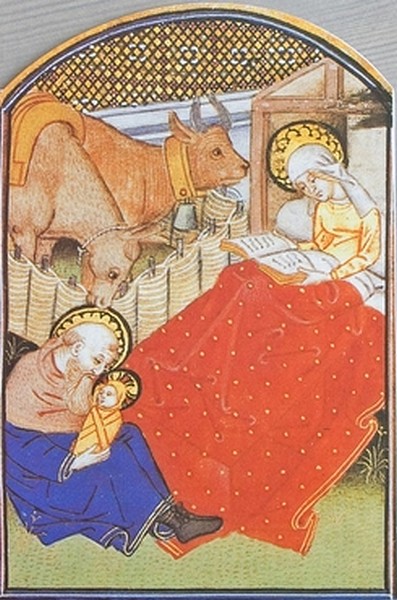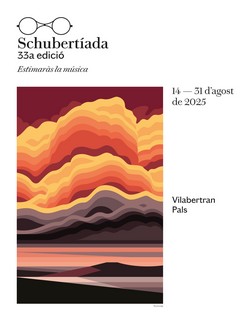
Mary reading - French Book of Hours (Fitzwilliam Museum)
Last week, we talked about one of the most common images in Christmas music, a child cradled in his mother’s arms; Today, we're talking about another essential idea in Christmas: light, since the winter solstice, which coincides with Christmas time (well, to be precise, it's the other way around) marks the return of light after winter’s long nights. Christian tradition puts together both images, the birth of a child is also the birth of light and hope, and so, we celebrate Saint Lucy's Day, decorate our homes with candles and after Tree Kings' Day, we realize with joy that, suddenly, days get longer. Northern lands suffer the lack of light more than we, Mediterranean people do, of course; They have extremely long nights and the sun shines so weakly that you hardly feel it on your face. In this context, the song I'm sharing today, Det mörknar ute (Outside it is growing dark) by Jean Sibelius, is really significant.
If I tell you that Sibelius' Opus no. 1 is called Five Christmas Songs, you might think (because it's what can be expected) that his first published work was a song cycle. Wrong. To begin with, it's no a cycle, we're talking about five songs with a common theme, which were composed between 1897 and 1913, probably to be sang by Sibelius' children; The composer published them in 1915 and I didn't get to know why it's Opus 1, because by that time, he had already published much of his work. It seems that the relationship between Sibelius and his editors was complicated and his catalogue was a mess...
The last of those five songs is from a poem in Finnish by Wilkku Joukahainen (one of only five songs that the composer wrote in that language); The rest of the poems are all from the same author, Zachris Topelius (1818-1898), one of the most important writers from Finland. One of his best-known works is Läsning för barn (Readings for children); It was published in eight volumes between 1865 and 1898 and nowadays, it's still being published. It's made up of tales and poems, many of them about Christmas, and Sibelius went back to it along the years to choose poems for his songs.
The two most popular songs in that collection are the last two, Julvisa and On hanget korkeat. Its chorale versions are very popular in Finland and are also arranged by Sibelius. Our song this week, Det mörknar ute, it's the third one, chronologically the first one, composed in 1897. As I told you before, it is about darkness and how the God’s light illuminates the world; The song structure is strophic and the accompaniment is simple, we can easily imagine people singing it in a church. The melody is based on two themes: the first one is repeated twice in each stanza and the second one, really beautiful, lasts the two last verses. Among the available versions of Det mörknar ute (not many, in fact), I chose that of Monica Groop and Love Derwinger, I like it very much. If you want to listen to a much more lively one (the difference is amazing), try with Tom Krause and Irvin Gage. And if you sing in a choir, I encourage you to include it in your repertoire, there will be a version for you!
I hope you'll like this Christmas song; it will be a good way to end this year. Next week, we will have a brand new year and will listen to one more song by Sibelius although we'll meet on Tuesday because Wednesday is Three Kings' Day and many of us will be very busy. Enjoy your New Year's Eve!
If I tell you that Sibelius' Opus no. 1 is called Five Christmas Songs, you might think (because it's what can be expected) that his first published work was a song cycle. Wrong. To begin with, it's no a cycle, we're talking about five songs with a common theme, which were composed between 1897 and 1913, probably to be sang by Sibelius' children; The composer published them in 1915 and I didn't get to know why it's Opus 1, because by that time, he had already published much of his work. It seems that the relationship between Sibelius and his editors was complicated and his catalogue was a mess...
The last of those five songs is from a poem in Finnish by Wilkku Joukahainen (one of only five songs that the composer wrote in that language); The rest of the poems are all from the same author, Zachris Topelius (1818-1898), one of the most important writers from Finland. One of his best-known works is Läsning för barn (Readings for children); It was published in eight volumes between 1865 and 1898 and nowadays, it's still being published. It's made up of tales and poems, many of them about Christmas, and Sibelius went back to it along the years to choose poems for his songs.
The two most popular songs in that collection are the last two, Julvisa and On hanget korkeat. Its chorale versions are very popular in Finland and are also arranged by Sibelius. Our song this week, Det mörknar ute, it's the third one, chronologically the first one, composed in 1897. As I told you before, it is about darkness and how the God’s light illuminates the world; The song structure is strophic and the accompaniment is simple, we can easily imagine people singing it in a church. The melody is based on two themes: the first one is repeated twice in each stanza and the second one, really beautiful, lasts the two last verses. Among the available versions of Det mörknar ute (not many, in fact), I chose that of Monica Groop and Love Derwinger, I like it very much. If you want to listen to a much more lively one (the difference is amazing), try with Tom Krause and Irvin Gage. And if you sing in a choir, I encourage you to include it in your repertoire, there will be a version for you!
I hope you'll like this Christmas song; it will be a good way to end this year. Next week, we will have a brand new year and will listen to one more song by Sibelius although we'll meet on Tuesday because Wednesday is Three Kings' Day and many of us will be very busy. Enjoy your New Year's Eve!
Det mörknar ute
Det mörknar ute och vindens sus
far över de dunkla dalar;
Natt faller över den armes hus
och rikemans stolta salar.
Var är det ljus, var är det ljus
som oss hugsvalar?
De eviga stjärnor stråla klart
i däldernas dunkel neder.
Av festliga ljus ett underbart,
ett länsande sken sig breder.
Kom snart Guds ljus, kom snart Guds ljus,
som allen oss lyser.
Allt mörker ljusnar för Herren Krist
som kom för att världen lysa.
Guds helga änglar med oljekvist
omskygga dem som frysa.
I kväll skall visst, i kväll skall vår
hydda änglarna hysa.
far över de dunkla dalar;
Natt faller över den armes hus
och rikemans stolta salar.
Var är det ljus, var är det ljus
som oss hugsvalar?
De eviga stjärnor stråla klart
i däldernas dunkel neder.
Av festliga ljus ett underbart,
ett länsande sken sig breder.
Kom snart Guds ljus, kom snart Guds ljus,
som allen oss lyser.
Allt mörker ljusnar för Herren Krist
som kom för att världen lysa.
Guds helga änglar med oljekvist
omskygga dem som frysa.
I kväll skall visst, i kväll skall vår
hydda änglarna hysa.
A fora es fa fosc i l'udol del vent
travessa les fosques valls.
La nit cau sobre la casa del pobre
i sobre els orgullosos salons del ric.
On és la llum, on és la llum
que ens porta consol?
Els estels eterns il·luminen clarament
la foscor de les valls.
Una meravellosa, radiant,
festiva llum comença a escampar-se.
Vine ràpida, llum de Déu
que tu sola ens il·lumines.
Tota la foscor s'il·lumina per Crist Nostre Senyor,
que va venir a il·luminar el món.
Els àngels beneïts per Déu, amb branques d'olives,
aixopluguen els que tremolen de fred.
Aquesta nit estarem segurs, aquesta nit
la nostra cabana acollirà els àngels.
One more thing: They don't know it but the image that illustrate this post was choosed by @juliaabelsmith, who tweeted it, and @Sinceritas_C, who retweeted. Its an illustration from the French Book of Hours kept at Fitwilliam Museum (Cambridge). I liked very much that unusual Mary reading. Thank you!














Comments powered by CComment